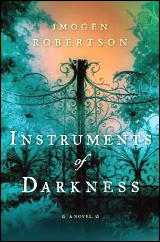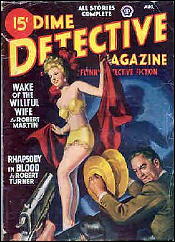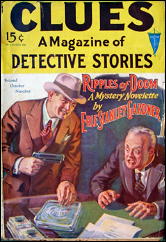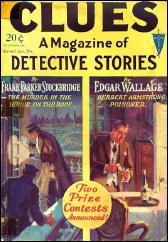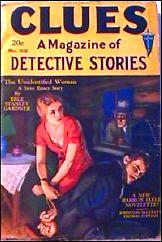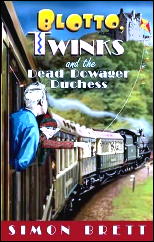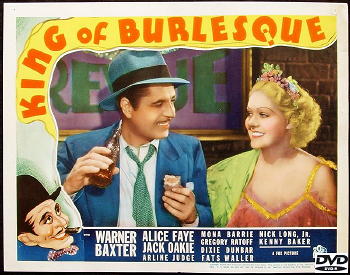February 2011
Monthly Archive
Thu 24 Feb 2011
Posted by Steve under
Reviews[5] Comments
LAWRENCE GOLDMAN – Tiger by the Tail. David McKay, hardcover, 1946. Hardcover reprint: Unicorn Mystery Book Club, 4-in-1 edition, October 1946. Also: Detective Book Magazine, Summer 1949.
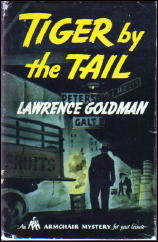
The detective in this tale, following closely in the footsteps of private eye Max Thursday and police sergeant Joe Friday, is (you guessed it) named Johnny Saturday, top trouble-shooting investigator for a west coast insurance outfit.
According to Hubin, Saturday was also the leading character in Fall Guy for Murder (Dutton, 1943), a book which I have not seen [but which at long last, thanks to the Internet, I now have on its way to me].
The scene is Los Angeles, more specifically the Market, the hub of the city’s fresh produce business; the time is right after the war, just as the country is beginning to show signs of getting itself back on its feet again.
At first the crimes are minor ones, such as sabotage and the hijacking of commodities like grapefruit and lettuce, but what has Saturday worried is a $20,000 policy on a dead man.
The writing is strictly pulpbound, evoking a period and flavor unmatchable outside the brittle pages of an aging Dime Detective Magazine, say (which, incidentally, cost 15 cents in 1946).
The plot is complicated, and perhaps it doesn’t make a lot of sense, but in its way I found it wholly representative of an entire era of mystery fiction writing, one that’ll never return.
— Reprinted from The MYSTERY FANcier, Vol. 3, No. 5, Sept-Oct 1979 (slightly revised).
Thu 24 Feb 2011
IT IS PURELY MY OPINION
Reviews by L. J. Roberts
IMOGEN ROBERTSON – Anatomy of Murder. Headline, UK, hardcover, 2010.
Genre: Historical mystery. Leading characters: Harriet Westerman & Gabriel
Crowther; 2nd in series. Setting: England-Georgian era/1781.
First Sentence: Captain Westerman was in his cabin reading the letter from his wife for the fourth time when he heard the officer of the morning watch ring Six Bells.
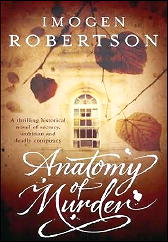
Mrs. Harriet Westerman and her friend, anatomist Gabriel Crowther, are once again embroiled in solving a murder. However, the stakes are even higher as they deal with treason against England during the Revolutionary War.
In a much less elegant part of London, a Tarot-card reader sees the impending murder of one of her clients. Although she fails in preventing the murder, she is determined to bring the woman’s killers to justice.
Beginning with an exciting and dramatic scene, this is one of those can’t-stop-until-I-finish-it books. Ms. Robertson’s writing is atmospheric and insightful with a strong sense of time and place, subtle, wry humor, a marvelous voice and style which evoke the period and the emotions of the characters.
I found it fascinating to see the Revolution from the English perspective. Harriet, intuitive and more able to relate to others, and Crowther, the cold, analytic scientist, balance each other well.
Harriet is someone who, as a real person, I should like very much. We learn more of Crowther and his past, which hints of much more to come. I am enjoying the evolution of their relationship despite the differences in the ages and natures.
All the characters are alive and wonderful. It’s nice to see the characters from the first book, including Molloy, and meet the delightful new characters Jocasta, Sam and Boyo. (I did feel a cast of characters would have been helpful.)
The captivating plot, good twist, the way in which the threads were brought together was wonderful. Set in 1781 during the Revolution, the story deals with traitors, murder and opera with a touch of the metaphysical. It takes you from the Opera house and salons of the wealthy to the meanest slums of London revealing the apathy and cruelty which resides in each.
Ms. Robertson is one of the best new-to-me-authors I’ve found this year. Her writing is insightful with interesting observations on celebrity worship, and encourages one to look at things from a different perspective. It is not often that events in a book make me truly cry, but it speaks to speaks to an author’s skill that her writing evokes strong emotion.
Anatomy of Murder was an excellent read but I recommend starting with her first book. I can’t wait for her next book.
Rating: Excellent.
The Harriet Westerman & Gabriel Crowther series —
1. Instruments of Darkness (2009)
2. Anatomy of Murder (2010)
3. Island of Bones (2011)
Thu 24 Feb 2011
REVIEWED BY GEOFF BRADLEY:
ACCUSED. BBC-TV, UK. 15 November through 20 December 2010. Featured players, left to right: Mackenzie Crook, Marc Warren, Juliet Stevenson, Naomie Harris, Christopher Eccleston, Andy Serkis, Benjamin Smith & Peter Capaldi. Creator: Jimmy McGovern.

This was a series of six separate plays (one hour each, no adverts) in which the central character is on trial and we see the story build up by a series of flashbacks of events leading up to the trial.
We see little of the trial itself until the final verdict which comes just before the conclusion of each story.
The series seemed promising since the writer was the much respected Jimmy McGovern, the man behind Cracker. It fact it turned out to be a series of unremitting and absolute tosh. I carried on watching story after story thinking that at least one of them must turn out well, but they were all deplorable.
The stories were designed, I think, to enlist sympathy for the defendant but in that respect (as in all others) they failed in this household. One problem, for this rosy-eyed watcher, was that it was difficult to find a likeable character in the whole series but, even worse, is that the actions of so many of the characters were just unbelievable on so many levels.
A series to be avoided.
Wed 23 Feb 2011
SINNING WITH LAWRENCE SANDERS
by George Kelley
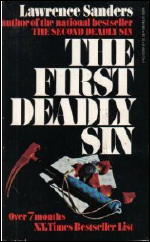
Lawrence Sanders is an inconsistent writer: he can turn out crud like The Pleasures of Helen and Love Songs, then startle readers with powerful novels like The First Deadly Sin (Putnam, 1973; Berkley, 1974), The Second Deadly Sin (Putnam, 1977; Berkley, 1978), and The Sixth Commandment (Putnam, 1979; Berkley 1980).
The First Deadly Sin is a one-on-one contest between a psycho named Daniel Blank and Captain Edward X. Delaney of the New York Police Department. Daniel Blank is obviously named by Sanders to represent a person reaching his limit; here’s how Blank sees the city he lives in:
“It was a city sprung and lurching. It throbbed to a crippled rhythm, celebrated death with insensate glee. Filth pimpled its nightmare streets. The air smelled of ashes. In the schools young children craftily slid heroin into their veins.” (Page10.)
Blank, divorced and alone, meets the fabulously wealthy Celia Montfort. A strange, sick relationship develops to the point where Blank decides he must prove his love to Celia. He does: Blank randomly picks a victim and kills him.
Blank returns to Celia and describes his feelings: “It really was pure. I swear it. It was religious. I was God’s will. I know that sounds insane. But that’s how I felt. Maybe it is mad. A sweet madness. I was God on earth. When I looked at people on shadowed streets Is he the one? Is he the one? My God, the power!” (Page 168.)
The man Blank murdered was Frank Lombard, a Brooklyn city councilman. The politicians of New York scream for vengeance and the inter-departmental maneuvers begin, first to solve the case quickly and reap the glory, later to scapegoat when the random killings continue.
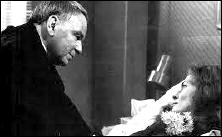
Delaney, asked by a cabal of police officers to quietly investigate the killings while he’s on leave, quickly comes up with important leads. Sanders plays fair with the reader: The First Deadly Sin is a near 600 page book, but the realistic frustration of following leads that turn out to be dead ends, the frustration of developing evidence, produces a long and involved narrative.
The character of Delaney, affectionately called “Iron Balls” by his fellow police officers, is interesting because of his toughness and his passion for order. His method consists of building a mental picture of the murderer, piece by piece:
“Delaney told his men-things like a man’s job, religion, politics, and the way he talked at cocktail parties-these were a facade he created to hold back a hostile world. Hidden were the vital things. The duty of the cops, when necessary, was to peek around the front at the secret urges and driven acts.” (Pages 60-61.)
Blank kills again. And again. Delaney’s mental pictures are still fuzzy. But Blank is slowly losing control: on his job he is aloof and distant. With Celia, with Celia’s brother, Blank’s sex acts become more bizarre. The killings inflame him:
“But when you kill, the gap disappears, the division is gone, you are one with the victim. I don’t suppose you will believe me, but it is so. I assure you it is. The act of killing is an act of love, ultimate love, and though there is no orgasm, no sexual feeling at all-at least in my case-you do, you really do, enter into all humans, all animals, all vegetables, all minerals. In fact, you become one with everything: stars, planets, galaxies, the great darkness beyond, and…” (Page 292).
The eerie picture of Daniel Blank is Sanders’ best writing: convincing and frightening at the same time. If The First Deadly Sin has a major weakness it is its ending. The one-on-one confrontation between Delaney and Blank breaks down and we are left with a drawn-out, frustrating ending.
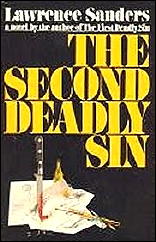
The Second Deadly Sin again features Delaney, but this time he’s drawn out of retirement to track down a murderer of a great painter.
Victor Maitland is stabbed to death and Delaney discovers a dozen suspects who’d like him dead. This is a whodunit, suspenseful and cleverly plotted.
Through the course of the book, it is Delaney, the character of an experienced and ruthless defender of justice, which overshadows the Maitland murder:
“But a cop had to go by Yes or No. Because… well, because there had to be a rock standard, an iron law. A cop went by that and couldn’t allow himself to murmur comfort, pat shoulders, and shake tears from his eyes. This was important, because all those other people — the ruth-givers (sic) — they modified the standard, smoothed the rock, melted the law. But if there was no standard at all, if cops surrendered their task, there would be nothing but modifying, smoothing, melting. All sweet reasonableness. Then society would dissolve into a kind of warm mush: no rock, no iron, and who could live in a world like that. Anarchy. Jungle. (Pages 143-144).
And, in the conclusion, Delaney forces the one-on-one confrontation and dishes out his own kind of justice.
The Sixth Commandment is a strange book. The story is told in the first person by Samuel Todd, an investigator for a philanthropic organization. Dr. Thorndecker, a Nobel Prize winner, asks the organization Todd works for for a million dollar grant to support his research.
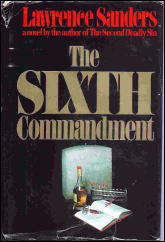
The organization has Todd investigate the Thorndecker proposal. Almost immediately, Todd receives an anonymous note: “Thorndecker kills.” Todd visits the site of the Thorndecker facility near the town of Coburn, north of New York City on the Hudson River. Initially he thinks the note is a con:
“In the groves of academe there’s just as much envy, spite, deceit, connivery, and backbiting as in Hackensack politics. The upper echelons of scientific research are as snaky a pit. The competition for private and federal funding is ruthless. Research scientists rush to publication, sometimes on the strength of palsied evidence. There’s no substitute for being first. Either you’re a discoverer, and your name goes into textbooks, or you’re a plodding replicator, and the Nobel Committee couldn’t care less. (Page 32.)
But Todd finds this isn’t a simple case of jealousy; there’s murder and madness and horror in Coburn beyond Todd’s wildest nightmares.
I recommend all three of Sanders’ books I’ve reviewed here. Sometimes the writing is wooden and dull, sometimes the characters are dull and superficial. But whatever Sanders’ faults, the books move with a power and intensity you should experience.
— Reprinted from The MYSTERY FANcier, Vol. 3, No. 5, Sept-Oct 1979.
Editorial Notes: This article appeared before the film version of The First Deadly Sin was released in 1980. The movie’s two leading co-stars were Frank Sinatra and Faye Dunaway, with David Dukes as Daniel Blank. Other books in the series were The Third Deadly Sin (1981) and The Fourth Deadly Sin (1985).
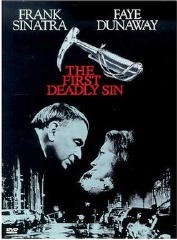
Other books in the “Commandment” series: Seventh (1991), Eighth (1986), and Tenth (1980). Sanders eventually turned his attention to series character Palm Beach PI Archie McNally, beginning with McNally’s Luck in 1992, although some if not all of the writing is said to have been done by ghostwriter Vincent Gardo.
There were seven in this lighthearted series under Sanders’ byline. When the latter died in 1998, Gardo wrote another five under his own name.
George Kelley’s blog can be found online here, where he finds something interesting to review and talk almost every day.
Tue 22 Feb 2011
THE STORY OF ALLEN HYMSON, MYSTERY WRITER
by
Victor A. Berch and Allen J. Hubin
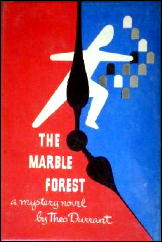
Since we spend quite a bit of time researching biographical details such as birth and death dates of various crime and mystery writers, my co-author queried me one day about the writer Allen Hymson.
Hymson’s claim to fame was his inclusion as one of the authors of the book The Marble Forest, published by the Alfred A. Knopf Co. of New York and copyrighted for publication on January 10, 1951. It was a collaborative effort on the part of twelve members of the California chapter of the Mystery Writers of America and published under the byline of Theo Durrant. [See also below.]
I quickly set to work to check through my various genealogical databases to see what might. be there of value concerning Allen Hymson.
Much to my surprise, the name Allen Hymson was nowhere to be found in any of the census records or birth and death records. I relayed that message back to Allen with the suggestion that perhaps he should contact the office of the Mystery Writers of America in order to learn just who was this Allen Hymson.
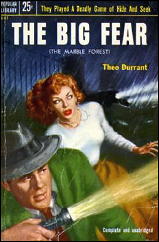
It didn’t take more than a few minutes for Allen to agree that this was a good suggestion and he sent off an e-mail to the office of the Mystery Writers of America. Within a day, an answer came back with the information that Allen Hymson was actually a pseudonym for Alma Hymson, a San Francisco writer. Along with that information came the revelations that Alma Hymson also used the pseudonyms Allen S. Jacobs and Edgar C. Nicholas, as well as Sylvia Blair.
Armed with that information, I quickly ran the names through the WorldCat database to see what books she may have written. Alas! Nothing turned up. What next? I took a stab at the Fictionmags database and there I hit a bit of pay dirt.
For there were entries for the pseudonyms Allen S. Jacobs, Allen Hymson and Edgar C Nicholas. But nothing for Sylvia Blair. Perhaps that had been used for newspaper publications at one time or another.
Taking another look at the pseudonyms, I thought “If Allen Hymson represented Alma Hymson, could the pseudonym Allen S. Jacobs represent Alma S. Jacobs?â€
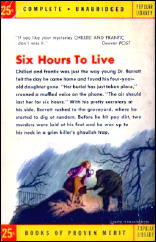
This opened a new avenue to explore and the answer to that puzzle lay in the fruits of a family tree on Ancestry.com labeled The Aaron and Jennie (Cohn) Jacobs Tree.
Here the complete story unfolded. An Albert J Hymson, born July 8, 1904 in Jefferson, KY and had died in San Francisco, CA on Oct. 25, 1950. His spouse was listed as Alma S. Jacobs. She was the offspring of Aaron and Jennie (Cohn) Jacobs. Her record revealed that she was born January 14, 1899 in California and had died in San Francisco April 12, 1995.
There were some family photographs and documents attached to the tree. One of particular interest was a document composed by Alma Hymson wherein she had traced some of her ancestors back to Spain and who were later expelled during the Spanish Inquisition and ended up in Eastern Europe. Anyone having access to Ancestry. com can examine the tree for whatever reason.
A Chronological Listing of the Writings of Alma Sylvia (Jacobs) Hymson:
Writing as Allen Hymson —
A Grave Mistake (ss) Dime Detective Magazine August 1947
Writing as Allen S. Jacobs —
Scented (ss) Clues Apr. 1927
Square Up (ss) Clues June 1927
The Dagger of Mahaputi (ss) Clues July 1927
The Trouble Cruiser (ss) Clues Oct. 1927
Foxiest Crook Living (ss) Clues Feb 25, 1928
Another Perfect Crime (ss) Clues Mar. 25, 1928
Three Gats (ss) Short Stories Mar. 25, 1928
— Short Stories (UK) Aug. 1928
Hard-Boiled Soft (ss) Clues Sep. 25, 1928
Easy Mark (ss) Clues Oct. 25, 1928
A Cinch Lay (ss) Clues Nov. 10, 1928
One Minute More (ss) Clues Jan 10, 1929
A Tight Squeeze (ss) Clues Feb. 10, 1929
The Menacing Garment (ss) Clues May 10, 1929
On An Even Draw (ss) Clues May 25, 1929
A Fraud In Pictures (ss) Clues June 10, 1929
Dead Partners (ss) Clues July 25, 1929
Sharpshooter (ss) Clues Aug. 10, 1929
The Machine Gun Racket (ss) Clues Sep. 10, 1929
Every Man For Himself (ss) Clues Dec. 25, 1929
Catspaw (ss) Clues Jan. 25, 1930
The Boasted Boomerang (ss) Clues Apr. 25, 1930
One Man’s Jinx (ss) Clues May 10, 1930
Reverse Luck (ss) Clues June 10, 1930
Convicting Evidence (ss) Clues Sep. 10, 1930
Chicken Feed (ss) All-Fiction Nov. 1930
Double Decoy (ss) Clues.Nov. 25, 1930
Better Dead Than Alive (ss) Clues Mar. 25, 1931
Nemesis (ss) Clues Apr. 25, 1931
The Dead Past (ss) Clues Feb. 1932
Coppered Bet (ss) Clues Apr. 1932
The Sinister Sap (ss) Clues May 1932
The Secret Address (ss) Clues Aug. 1932
Under The Gun (ss) Rapid-Fire Detective Stories Oct. 1932
Trial By Gunfire (ss) World Stories Feb. 1933
Writing as Edgar C Nicholas —
Queer Business (ss) Clues Oct. 1927
Taken For A Ride (ss) Clues Oct. 25, 1928
Which Way The Cat Jumps (ss) Clues Feb. 10, 1929
It has yet to be determined which part of The Marble Forest Alma Hymson had written.
The authors would like to express their sincere thanks to Ms. Margery Flax of The Mystery Writers of America office in New York for her able assistance in helping to put the pieces of this puzzle together.
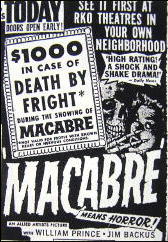
THE MARBLE FOREST, by Theo Durrant, a joint pseudonym of William A. P. White (Anthony Boucher), Terry Adler, Eunice Mays Boyd, Florence Faulkner, Allen Hymson, Cary Lucas, Dana Lyon, Lenore Glen Offord, Virginia Rath, Richard Shattuck, Darwin L. Teilhet & William Worley. Alfred A. Knopf, hardcover, 1951. Popular Library #507, paperback reprint, 1953 as The Big Fear. Filmed as Macabre (Allied Artists, 1958; director: William Castle).
From Jeffrey Marks’ recent biobibliography of Anthony Boucher, The Marble Forest was far less a detective novel than it was a thriller in which a young girl is buried in a coffin with only five or six hours to live. The Northern California chapter of the MWA held a contest challenging readers to determine which author wrote which chapters.
From TCM.com: “For $5,000, he [William Castle] purchased an insurance policy from Lloyds of London guaranteeing a $1,000 payout to the beneficiaries of anyone felled by fright while watching Macabre.”
A Special Note: The pulp cover images used in this post came from Phil Stephensen-Payne’s Galactic Central website. Follow, for example, the link to Pulp Magazines, then to Clues, then to Issue Checklist. The result will take your breath away.
Tue 22 Feb 2011
We’re still in the process of going through some of the typos and other small errors that always creep into a project like this, but Part 40 of the online Addenda to the Revised Crime Fiction IV, by Allen J. Hubin, is now online. (Follow the links.)
There are the usual additions: newly discovered series characters and settings for the novels, a few new authors and novels, dates of birth and death added or corrected. A whole gamut of facts and additional information about our favorite hobby: reading and collecting detective and mystery fiction, some of it generated by the reviews and other discussions that have recently taken place on this blog.
The corrections to Part 40 of the online Addenda will be made in the next couple of days, but one of the highlights of this particular installment deserves a post here on this blog all to itself, the discovery of a female identity to a masculine byline that occurred frequently in the heyday of the hard-boiled detective pulp magazines.
I’ll let Victor Berch tell you all about it in the very next post.
Mon 21 Feb 2011
Reviewed by DAVID L. VINEYARD:
SIMON BRETT – Blotto, Twinks and the Ex-King’s Daughter. Felony & Mayhem, softcover, February 2011. British edition: Constable, hardcover, May 2009.
The name Simon Brett should be no stranger to anyone on these pages. His Charles Paris series about a bibulous actor is held in the highest esteem by lovers of humorous well written mysteries, and for the past decade he has been penning less humorous but well received British cozies set in Fethering, a small English town out of Miss Marple by way of The Last of the Summer Wine.
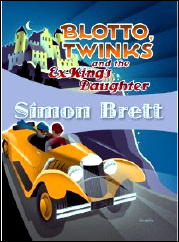
Blotto, Twinks and the Ex King’s Daughter is yet another venue for Mr. Brett, and one that shows a different side both to his humor and English village life. Indeed, his new series lies somewhere in that vague country inhabited by P.G. Wodehouse’s Jeeves and Wooster, Dornford Yate’s Berry and Company, some of the more playful Agatha Christie’s, the early Albert Campion, the more extravagant adventures of Michael Innes Sir John Appleby, and Leonard Wibberly’s Duchy of Grand Fenwick.
The time is somewhere between the two world wars in an England of stately homes, dizzy aristocrats, loyal retainers, dastardly villains, and vintage automobiles.
The setting is Tawcester Towers, where the Dowager Duchess of Tawcester (the Duke, her son — known as Loofah and Rupert the Dull, descendant of Rupert the Fiend and Black Rupert — having passed on five years earlier) is entertaining the exiled king of Mittleuropa, Sigismund, when her youngest son, the Right Honorable Devereaux Lyminster, known as Blotto (and with good reason) announces he’s found a body in the library, one Captain Schtoltz.
“It’s frightfully awkward, Mater, but there’s a dead body in the library.”
In very short order Chief Inspector Trumbull and Sergeant Knatchbull arrive, none too impressed by the body or the Duchess and her royal guest, and then to add to the trouble the Princess Ethelinde is kidnapped.
Well, naturally Blotto can’t allow that kind of thing to happen in Tawcester Towers without doing something, but considering his limited capacity in the brains department, it is just as well his beautiful sister Lady Honoria, known as Twinks, has a first rate mind and nose for murder (“– what a brainbox that girl had”).
And the chase is on — in vintage open automobiles of course — and with Grimshaw, Blotto’s valet, in tow (a gentleman never travels without his valet) all the way to Mittleuropa, where they stumble on intrigue supplied by nearby Transcarpathia, ruled by King Anatol and Princess Ethlinde’s betrothed, Prince Fritz-Ludwig among others.
Before you can say Zenda…, Blotto and Twinks (Grimshaw in tow) are on the trail of the murderer in the capital Zling and over the battlements of the Castle Berkenziepenkatzen … assuming you actually can say any of that.
Of course Blotto will rescue the Princess and nobly renounce said princess in true Rassendyl style (he has to get out of it somehow) while Twinks will hunt down the kidnapper and murderer displaying both brains and spunk, but it is all a near run thing — especially for Blotto, who might have ended up king of Mittleuropa, or in the arms of the dangerously attractive Svetlana Lubachev (“as a femme fatale she did have some standards”). All before Blotto confronts the killer back in England at jolly old Tawcester Towers in Rupert the Antisocial’s billiard room.
This is a very funny book, inventively, and splendidly, silly, bright, clever, and outrageous. There isn’t a serious bone in its head. I’m not really sure a mere reviewer can convey the exact spirit and voice of the book, but if you want to escape from reality into a world of smiles, chuckles, and undignified guffaws, this is your chance. Wodehousian, yes, but with a few left turns reminiscent of the Marx Brothers or Mel Brooks, and all bundled up as an attractive new series we can only hope to see more of.
If you want a few laughs you’d be blotto not to read it.
The Blotto & Twinks series —
1. Blotto, Twinks, and the Ex-King’s Daughter (2009)
2. Blotto, Twinks and the Dead Dowager Duchess (2009)
3. Blotto, Twinks and the Rodents of the Riviera (2011)
Mon 21 Feb 2011
Posted by Steve under
ReviewsNo Comments
A REVIEW BY RAY O’LEARY:
SIMON BRETT – Mrs. Pargeter’s Package. Scribner’s, hardcover, 1991. Warner, reprint paperback, 1992. UK edition: Macmillan, hardcover, 1990.
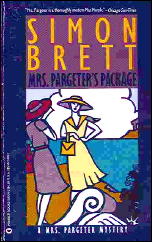
Mrs. Pargeter, the widow of a master criminal with lots of friends, decides to accompany an old friend, Joyce Dover (is this name in homage to Joyce Porter, author of the Dover books?) herself a recent widow, on a package tour of Corfu in Greece.
As they go through Customs, she asks Mrs. Pargeter to carry a package for her, and the next day Joyce’s body turns up, an apparent suicide. Mrs. Pargeter is, of course, suspicious. She slept a bit too soundly the night of her friend’s death, and their luggage seems to have been searched.
Worse, the local police seem entirely too anxious to label the death Suicide and forget about it. But stranger still, the package Mrs. Pargeter was carrying for her friend turns out to be a bottle of Ouzo: So why was Joyce smuggling Greek Wine into Greece?
Myself, I can’t fathom why Brett is becoming so enamoured of Mrs. Pargeter when Charles Paris is such a much more entertaining character. Mrs. P., despite her friends, is pretty much interchangeable with any number of LOLs, and this case is completely conventional and without a single memorable incident.
Mon 21 Feb 2011
A 1001 MIDNIGHTS Review
by Newell Dunlap & Bill Pronzini
SIMON BRETT – A Comedian Dies. Scribner’s, hardcover, 1979. Reprint paperbacks include: Berkley, 1980; Dell, 1986; Warner, 1990. UK edition: Victor Gollancz, hardcover, 1979.
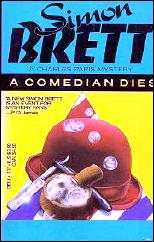
Making good use of his background in radio and television, and of his interest in the theater, Simon Brett has created one of the most likable characters among recent series sleuths: Charles Paris, a middle-aged and not very successful radio actor whose vices include drink, women, and stumbling into murder cases that he is forced to solve.
The Paris novels are distinguished by solid plotting, well-drawn entertainment business backgrounds, and a nice interweaving of humor that often borders on spoof.
One of the first things the reader of A Comedian Dies, which has a modem British vaudeville background, will notice is that there is a gag at the beginning of each chapter. A gag such as:
Feed: I heard on the radio this morning that the police are looking for a man with one eye.
Comic: Typical inefficiency.
Having discovered this, most readers will no doubt be tempted to flip through the book and read all of the gags immediately, like gulping popcorn. You should refrain from doing this, however. Taken one at a time, every dozen pages or so, each will provoke an amused and tolerant groan; taken all at once, they are sort of like listening to a Bob Hope monologue and may therefore cause severe trauma, if not a sudden desire to take up golf or vote Republican.
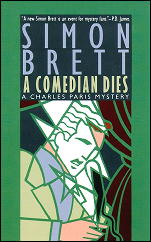
On the other hand, the novel itself is worth reading all at once. Paris and his estranged wife, Frances, trying once again to mend their marriage, are attending a vaudeville show at the Winter Gardens in Hunstanton, a small English seacoast town. But the show the star performer, comedian Bill Peaky, puts on is not at all what Paris anticipated: Peaky is electrocuted on stage while clutching his electric guitar and microphone.
At the inquest, the coroner decides the death was accidental, due to faulty wiring, but Paris has his doubts and starts an investigation of his own. Suspects abound, owing to the fact that Peaky was not a very popular fellow. Paris is something of a bumbler, which only enhances his appeal; and he does get to the bottom of things eventually, in spite of the eighteen gags Brett throws at him along the way.
Feed: Do you know, they say that whisky kills more people than bullets.
Comic: Ah well, that’s because bullets don’t drink.
———
Reprinted with permission from 1001 Midnights, edited by Bill Pronzini & Marcia Muller and published by The Battered Silicon Dispatch Box, 2007. Copyright © 1986, 2007 by the Pronzini-Muller Family Trust.
Mon 21 Feb 2011
REVIEWED BY WALTER ALBERT:
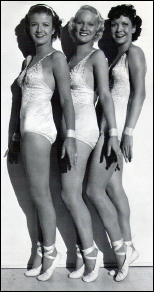
KING OF BURLESQUE. 20th Century Fox, 1936. Warner Baxter, Alice Faye, Jack Oakie, Mona Barrie, Gregory Ratoff, Dixie Dunbar, Herbert Mundin, Thomas “Fat” Waller, Kenny Baker. Screenplay by Gene Markey and Harry Tugend, from Viña Delmar’s unpublished short story “The Day Never Came.” Director: Sidney Lanfield. Shown at Cinecon 46, Hollywood CA, September 2010.
Last year at Cinevent I saw the 1943 technicolor remake of this Fox musical, Hello Frisco, Hello [reviewed here ], with Alice Faye and Jack Oakie repeating their earlier roles. I didn’t particularly like the remake, and I can now say that I definitely didn’t like the original version.
Warner Baxter plays a successful director of musicals who falls for a society dame and is convinced by her to “upgrade” his shows. His career and marriage founder, but his former pals, Faye and Oakie, come to his rescue and Faye graduates from best pal to girlfriend/future wife status.
I found the 1936 version to be a tedious, hackneyed backstage drammer, occasionally brightened by the musical performers, with “Fats” Waller momentarily lifting the movie out of its well-worn rut. Warner Baxter had played the hotshot director one time too many, and his take on the role was funny when it wasn’t intended to be.
Editorial Note: Of the three chorus girls in that eye-catching image you see above, the one on the right is Jane Wyman.
« Previous Page — Next Page »


